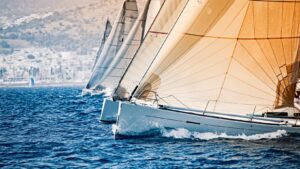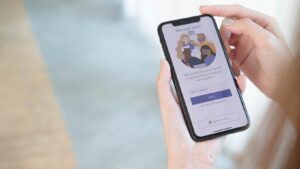Sailing is a popular pastime for many people, but in order to have a successful and enjoyable experience, it is important to know the ideal wind speed for sailing. The wind speed can have a major impact on the sailboat, affecting factors such as speed, stability and manoeuvrability.
There is no single answer to the question of what the ideal wind speed for sailing is, as it depends on a number of factors, including the type of sailboat, the experience of the sailors and the weather conditions. In general, however, there are some guidelines that can be followed.
For beginners, it is generally recommended that the wind speed should be between 10 and 15 knots. This is because higher wind speeds can make sailing more difficult and challenging, particularly for those who are not experienced. In addition, higher wind speeds can also lead to choppier waters, which can make sailing less enjoyable.
For more experienced sailors, they may be able to handle higher wind speeds, but it is still important to be aware of the conditions and to exercise caution. In general, winds above 20 knots are considered to be strong and should be approached with caution.
Finally, it is also important to consider the weather conditions when deciding on the ideal wind speed for sailing. For example, if there is a chance of storms or high waves, it is generally advisable to reduce the wind speed accordingly.
In conclusion, there is no definitive answer to the question of what the ideal wind speed for sailing is. However, by taking into account factors such as the type of sailboat, the experience of the sailors and the weather conditions, it is possible to get an idea of what will be best for your particular situation.
The History of Sailing
Sailing has been a popular form of transportation and recreation for centuries. The wind is used to push against the sails of a boat, which propels it forward. The first recorded use of sailing boats dates back to around 4000 BCE, in the ancient civilizations of Egypt and Mesopotamia.

Over the years, sailing boats have become more advanced, and different types have been developed for different purposes. Today, sailing is still a popular sport and hobby, and there are many competitions held around the world.
The ideal wind speed for sailing depends on the type of boat you are using. Smaller boats, such as dinghies, can be sailed in relatively light winds. Larger boats require stronger winds to move them through the water.
In general, the ideal wind speed for sailing is between 10 and 20 knots (18-37 km/h). This is enough wind to fill the sails without making it too difficult to control the boat. If the wind is too strong, it can be dangerous as it can easily capsize a boat.
If you are just starting out, it is best to sail in winds that are on the lower end of this range. As you become more experienced, you will be able to sail in stronger winds.
The Physics of Sailing
The physics of sailing are complex. Wind speed and direction, as well as the shape and orientation of a boat’s hull, all affect how fast it can travel through the water.
However, there is a general range of wind speeds that are considered ideal for sailing. For most boats, the ideal wind speed is between 10 and 20 knots (11.5 to 23 mph). This range of wind speeds is sufficient to provide good forward motion, but not so strong that it becomes difficult to control the boat.
Of course, the ideal wind speed for sailing will vary depending on the specific type of boat being used. For example, smaller boats such as dinghies can be sailed in winds as low as 5 knots (5.8 mph), while larger boats may require wind speeds of 25 knots (29 mph) or more to achieve good forward motion.
In general, lighter boats are able to sail in stronger winds than heavier boats. This is because heavier boats have more inertia and are less affected by the force of the wind. However, even the lightest boat will eventually reach a point where the wind is too strong to sails safely, so it is important to know the limits of your boat before heading out onto the water.
What is The Correct Wind Speed for Sailing
The ideal wind speed for sailing depends on the type of boat, the sails, the crew and the weather conditions. In general, most boats will sail best in winds between 8 and 20 knots. However, some boats can sail in winds as low as 6 knots, and others can sail in winds up to 25 knots. The best way to determine the ideal wind speed for your boat is to consult your owner’s manual or a qualified sailing instructor.
The Benefits of Sailing
Sailing is a fun and relaxing activity that can be enjoyed by people of all ages. It can also be a great workout, depending on the wind conditions. But what is the ideal wind speed for sailing?
The ideal wind speed for sailing depends on the type of vessel you are using, as well as your level of experience. For novice sailors, it is generally recommended to sail in winds that are between 5 and 15 knots. This will provide enough wind to keep the sails filled, but not so much that it becomes difficult to control the vessel.
For more experienced sailors, higher wind speeds can be more enjoyable. In general, winds between 15 and 25 knots are idea for sailing. These winds will provide enough power to really get the boat moving, but won’t be so strong that they become dangerous.

Of course, the ultimate decision of whether or not to sail in a particular wind speed is up to the captain of the vessel. They will take into account factors such as the weather forecast, the sea conditions, and their own level of experience in order to make a decision about whether or not it is safe to sail.
The Dangers of Sailing
The dangers of sailing in high winds are many and varied. In the most extreme conditions, a vessel can be dismasted, or even capsized and sunk. In less severe conditions, a vessel may simply be blown off course, or suffer damage to sails or rigging.
That said, there is no such thing as an “ideal” wind speed for sailing; it all depends on the vessel, the crew, the conditions, and the captain’s preference. In general, however, it is considered safe to sail in winds up to 20 knots (about 23 mph). Beyond that, it becomes increasingly risky; at 30 knots (about 35 mph), even experienced sailors begin to exercise caution.
Conclusion
In conclusion, the ideal wind speed for sailing differs depending on the type of sailboat, the sails, the size of the crew, and the sea conditions. In general, it is best to sail in winds that are between 10 and 20 knots.


